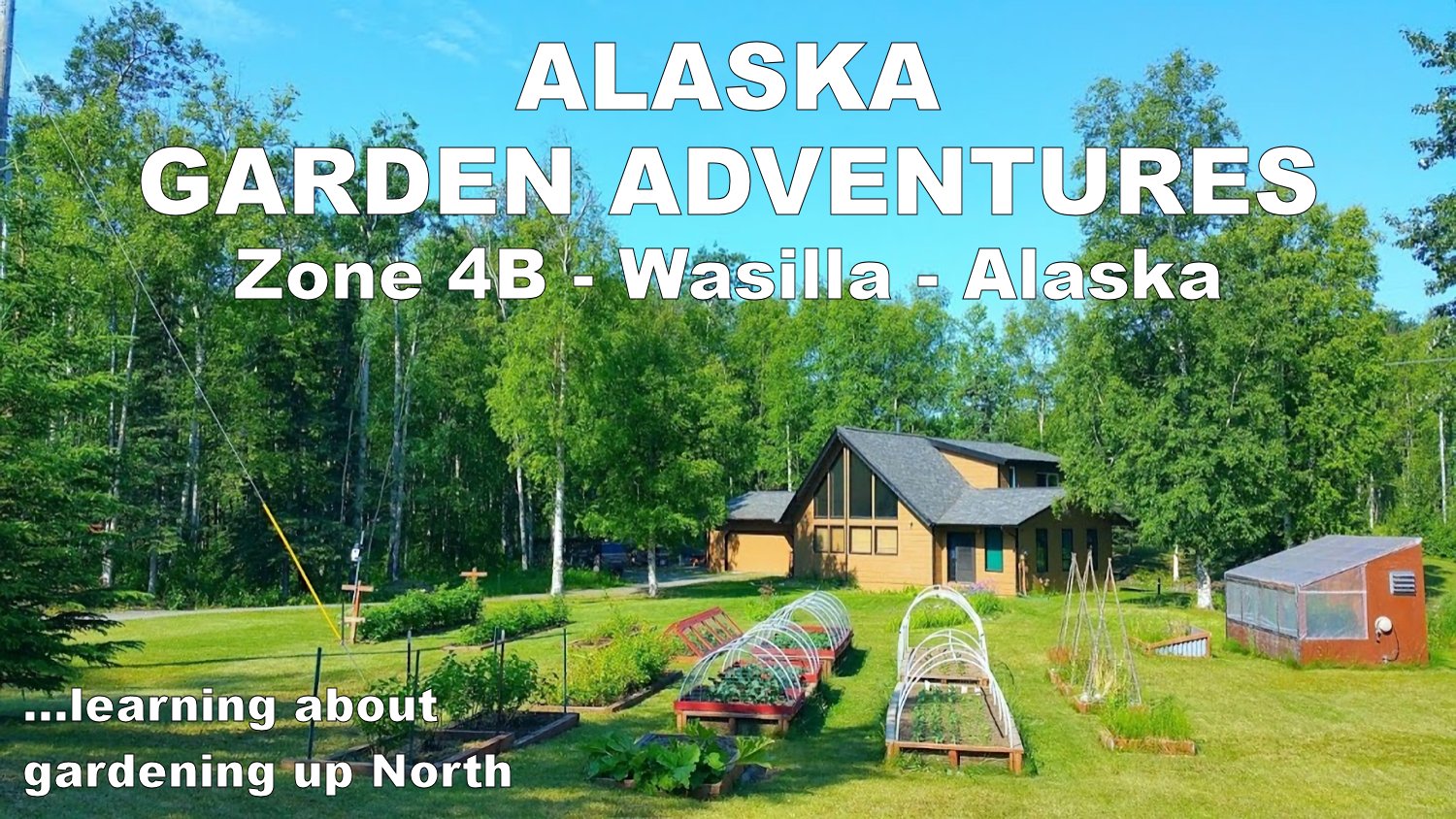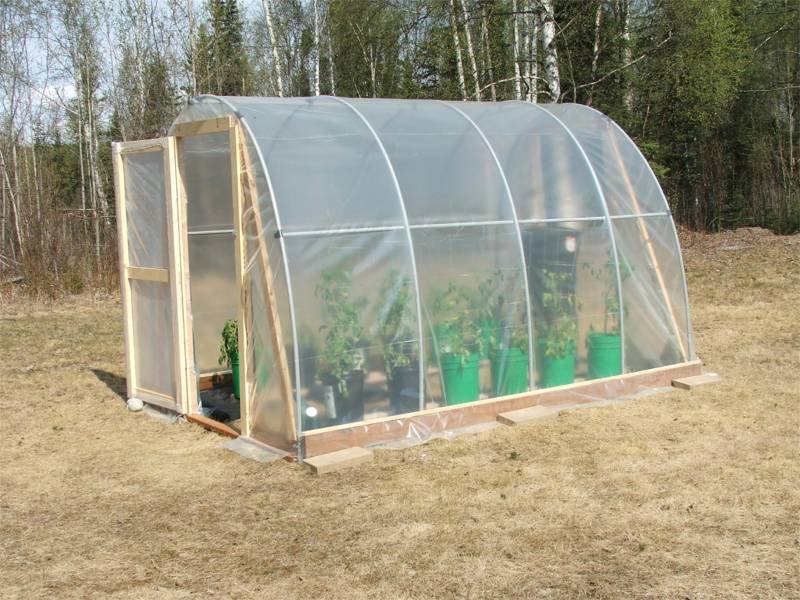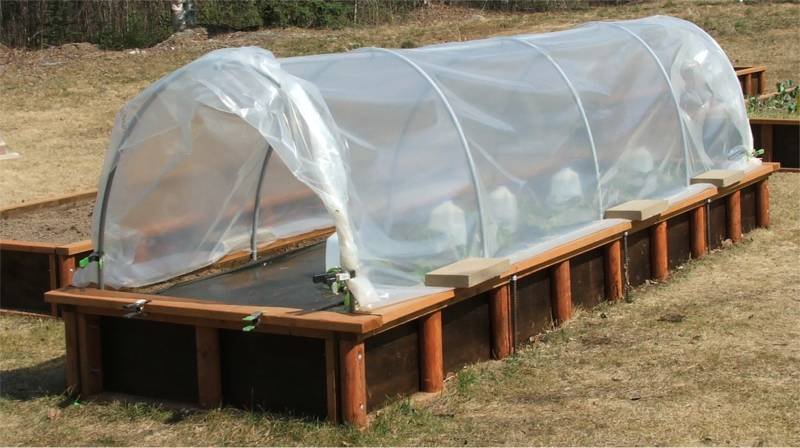The number one challenge about gardening in Alaska is our short and cool growing season. Where I live in the Mat-Su valley - USDA hardiness zone 3-4 - and in the Anchorage area we average about 100-110 frost free days, and with 20 hours of daylight in June it is like adding another 2-3 weeks or about the same as a 120 day growing season. With our cool weather some warm season vegetables just won’t germinate or set fruit if the temperature stays below 60 degrees and Anchorage averages only 18 days above 70 degrees F per year. If you want to grow long season or warm season vegetables, like tomatoes and peppers, you really need some type of greenhouse to create a warmer micro-climate and extend your growing season.
A full size Greenhouse is a choice for many gardeners. This can be a simple DIY Hoop Greenhouse made from plastic conduit and covered with clear plastic, like a hoop tunnel only larger. Commercial Greenhouse kits are available, but can be very expensive for the home gardener. Building a DIY greenhouse takes skill and can also be expensive. Designing a greenhouse for your location and the Alaska climate that will fit your needs is the key that many commercial Greenhouse kits do not address. Most serious gardeners want a more permanent structure that will withstand our Alaska weather and snowy winters. You will have to decide if you want to buy a greenhouse or build one yourself.
To extend our growing season depends on 2 factors Heat and Light. You can add supplemental heat with a gas or electric heater and use special grow lights when the days are too short. Running a heater and electric lights can be expensive. A single layer plastic covered Greenhouse has no real insulation value. This type of unheated greenhouse will lose heat at night or whenever the sun is not shining directly on your greenhouse. There are some methods that can store excess heat to use when needed, like water-filled barrels that warm up and can hold some heat. They can add a few degrees but just don’t do a good job on clear frosty nights or on cold cloudy days. I do use a small electric space heater in early spring and fall when freezing nights are a real risk. My small space heater can add 10-20 degrees F inside my 8X16 ft. greenhouse.
You can calculate heat loss that is determined by insulation value and then you can calculate the amount of heat needed and the correct heat source it will take to replace the heat loss and keep your greenhouse above freezing. I tried using a propane wall heater but found out quickly that I needed a lot of fuel and it was expensive. It is really not practical to think you can grow vegetables in a greenhouse all year in Alaska, but it is possible to extend the growing season by 4 to 8 weeks with a good design and some supplemental heat.
A simple low hoop tunnel made with plastic conduit and covered with clear plastic will help. I also use IRT mulch (Infrared Transmitting plastic) ground cover in my hoop tunnels to help warm up the soil.
My goal is to conserve heat or at least slow the heat loss and reduce the time needed to add supplemental heat. Supplemental lighting can also be added but also requires electricity. Natural sunlight is free and abundant during our short summer season. Solar heat gain is also a natural property from sunlight as long as the sun is shining on your greenhouse windows. Too much solar heat gain on a clear sunny day is also a factor that requires some way to remove this excess heat when necessary. It can be as simple as rolling up the plastic sides or opening windows and doors. This manual method works, but you must be present or risk heat damage if you are gone. I use a combination of an electric vent fan that is controlled by a thermostat and turns on my fan at 80 degrees F and automatic window openers that open my windows for me. This does require an electric vent fan. I did try a Solar-electric powered vent fan for many years, but it was simply not powerful enough to remove excess heat on long sunny days. I always resorted to opening the door and adding extra electric fans to move enough air.
To take advantage of the free solar heat and sunlight we have I designed my greenhouse to face due South and has no windows on the North side. The sun, at this latitude, only shines on the North side in early morning and late evening and most of the day the North side gets no direct sunlight, so those windows will lose heat.
A solid and well insulated North wall is a much better way to reduce heat loss. On March 21 after the Spring Equinox we do have 12 hours of free sunlight that could be enough for growing plants in a greenhouse, but you still have 2 months of freezing weather to worry about and that requires adding heat. There is no free heat when the sun is not shining directly onto your greenhouse.
The only thing I would change about this design is the foundation and the floor. Since our ground freezes very deep every winter and takes a very long time to warm up every spring, I chose a raised insulated wood floor to reduce heat loss from the cold ground. Heat loss through cold ground is an important consideration and a level floor is necessary for my gravity feed Alaska Grow Buckets self watering garden system.
Water damage to my plywood floor is a problem. A waterproof floor with good drainage would have been a better choice but would cost more and was just not in my original budget. I would suggest landscape cloth covered with pea gravel or crushed rock base with drainage tubing covered with paver bricks for easy water drainage. To reduce heat loss, from frozen ground in my location, you could add a 2 inch foam board insulation layer below the gravel base.
I start my seeds indoors in my living-room in February and use electric LED grow-lights above my seed starting trays. It is much more economical than heating and lighting a greenhouse. Your home is already heated and you have electricity for your grow lights.
Since I start my seeds indoors and have shelving units for holding seed trays I can convert these for growing small plants indoors in our long winters. Growing herbs, salad greens, and even cherry tomatoes indoors is easy and anyone can grow some fresh vegetables all year long.











